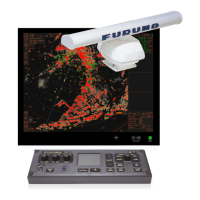4. AIS OPERATION
4-17
12. Select [OK], then push the ADJUST knob.
13. Select [SAVE FILE], then push the ADJUST knob.
14. Select the appropriate number, then push the ADJUST knob.
15. Close the menu.
4.15.2 How to transmit messages
1. Select the [AIS] box at the right of the screen, then press the right button. The
[AIS TARGET MENU] appears.
2. Do one of the following:
a) Create a message, as described in paragraph 4.15.1.
b) Use a file saved in the memory by selecting [TRANSMIT MESSAGE] followed
by [OPEN FILE].
3. Select [TRANSMIT MESSAGE] to transmit the message.
4. Close the menu.
The indication "AIS TRANSMITTING" appears while sending the message.
"TRANSMIT ERROR" appears if an error occurred while transmitting the message.
4.15.3 How to view messages
When an AIS message is received, the
display shows an appropriate icon to
alert you. If [AUTO DISP MESSAGE] in
the [AIS TARGET MENU] is set to
[ON], messages are automatically dis-
played upon receipt. The system
stores up to 20 AIS messages. When
the storage capacity is reached the old-
est AIS message is automatically
erased to make room for the latest.
Note that received messages and
alarm messages are not backed up
when the power is turned off.
1. Select the [AIS] box at the right of
the screen, then press the right
button. The [AIS TARGET MENU]
appears.
2. Select [RECEIVED MESSAGES], then push the ADJUST knob. Up to four mes-
sages are displayed per page and a total of 200 messages can be stored.
3. Select the message to be displayed, then push the ADJUST knob.
4. The message details are displayed below the message list.
Message type Max. characters allowed
Safety message broadcast 161
Binary message broadcast 156
Safety message addressed to MMSI 156
Binary message addressed to MMSI 151
Currently displayed
page no.
Message list
Display next page.
Name and Call Sign
of selected
message’s sender.
Message details
Close message list.
When displayed as
“BACK”, goes back
one page in the list.

